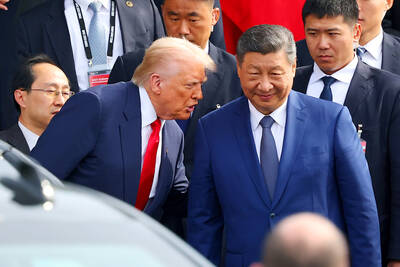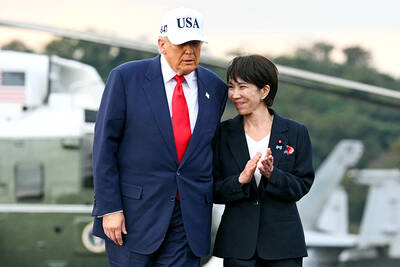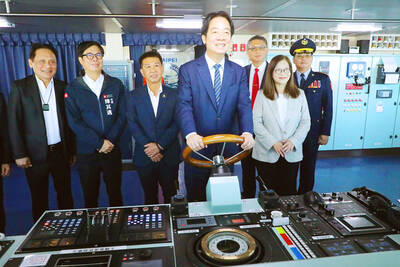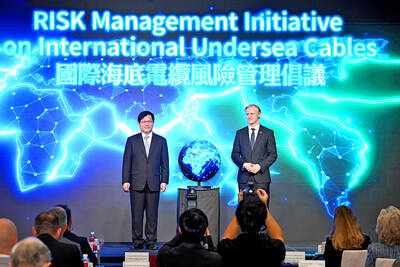North and South Korea yesterday fired hundreds of artillery shells into each other’s waters in a flare-up of animosity that forced residents of five front-line South Korean islands to evacuate to shelters for several hours, South Korean officials said.
The exchange of fire into the Yellow Sea followed Pyongyang’s sudden announcement that it would conduct live-fire drills in seven areas north of the Koreas’ disputed maritime boundary.
North Korea routinely test-fires artillery and missiles into the ocean, but rarely discloses those plans in advance. The announcement was seen as an expression of Pyongyang’s frustration at making little progress in its recent push to win outside aid.
North Korea fired 500 rounds of artillery shells over more than three hours, about 100 of which fell south of the sea boundary, South Korean Ministry of National Defense spokesman Kim Min-seok said.
South Korea responded by firing 300 shells into North Korean waters, he said.
No shells from either side were fired at any land or military installations, but Kim called the North’s artillery firing a provocation aimed at testing Seoul’s security posture. There was no immediate comment from North Korea.
Yesterday’s exchange was relatively mild in the history of animosity and violence between the Koreas, but there is worry in Seoul that an increasingly dissatisfied North Korea could repeat the near-daily barrage of war rhetoric it carried out last spring, when tensions soared as Pyongyang threatened nuclear strikes on Washington and Seoul in response to condemnation of its third nuclear test.
Residents on front-line South Korean islands spent several hours in shelters during the firing, and officials temporarily halted ferry service linking the islands to the mainland.
The poorly marked western sea boundary has been the scene of several bloody naval skirmishes between the Koreas in recent years.
In March 2010, a South Korean warship sank in the area following a torpedo attack blamed on Pyongyang that left 46 sailors dead. North Korea denies responsibility for the sinking.
In November 2010, a North Korean artillery bombardment killed four South Koreans on Yeonpyeong.

UKRAINE, NVIDIA: The US leader said the subject of Russia’s war had come up ‘very strongly,’ while Jenson Huang was hoping that the conversation was good Chinese President Xi Jinping (習近平) and US President Donald Trump had differing takes following their meeting in Busan, South Korea, yesterday. Xi said that the two sides should complete follow-up work as soon as possible to deliver tangible results that would provide “peace of mind” to China, the US and the rest of the world, while Trump hailed the “great success” of the talks. The two discussed trade, including a deal to reduce tariffs slapped on China for its role in the fentanyl trade, as well as cooperation in ending the war in Ukraine, among other issues, but they did not mention

Japanese Prime Minister Sanae Takaichi yesterday lavished US President Donald Trump with praise and vows of a “golden age” of ties on his visit to Tokyo, before inking a deal with Washington aimed at securing critical minerals. Takaichi — Japan’s first female prime minister — pulled out all the stops for Trump in her opening test on the international stage and even announced that she would nominate him for a Nobel Peace Prize, the White House said. Trump has become increasingly focused on the Nobel since his return to power in January and claims to have ended several conflicts around the world,

CALL FOR SUPPORT: President William Lai called on lawmakers across party lines to ensure the livelihood of Taiwanese and that national security is protected President William Lai (賴清德) yesterday called for bipartisan support for Taiwan’s investment in self-defense capabilities at the christening and launch of two coast guard vessels at CSBC Corp, Taiwan’s (台灣國際造船) shipyard in Kaohsiung. The Taipei (台北) is the fourth and final ship of the Chiayi-class offshore patrol vessels, and the Siraya (西拉雅) is the Coast Guard Administration’s (CGA) first-ever ocean patrol vessel, the government said. The Taipei is the fourth and final ship of the Chiayi-class offshore patrol vessels with a displacement of about 4,000 tonnes, Lai said. This ship class was ordered as a result of former president Tsai Ing-wen’s (蔡英文) 2018

GLOBAL PROJECT: Underseas cables ‘are the nervous system of democratic connectivity,’ which is under stress, Member of the European Parliament Rihards Kols said The government yesterday launched an initiative to promote global cooperation on improved security of undersea cables, following reported disruptions of such cables near Taiwan and around the world. The Management Initiative on International Undersea Cables aims to “bring together stakeholders, align standards, promote best practices and turn shared concerns into beneficial cooperation,” Minister of Foreign Affairs Lin Chia-lung (林佳龍) said at a seminar in Taipei. The project would be known as “RISK,” an acronym for risk mitigation, information sharing, systemic reform and knowledge building, he said at the seminar, titled “Taiwan-Europe Subsea Cable Security Cooperation Forum.” Taiwan sits at a vital junction on